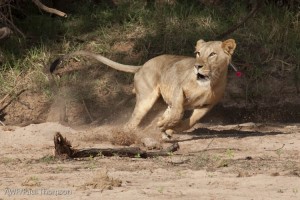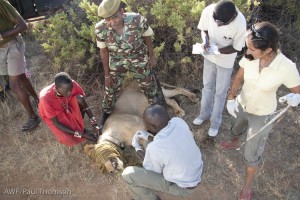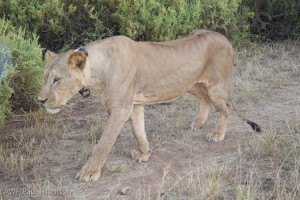Collaring a Lion
After two long days of searching without success, we finally found the lion. I had been out in Buffalo Springs looking there, while Shivani was in Samburu Reserve. At 6:36 in the morning, Shivani - the AWF Charlotte Fellow - had found a pair of males basking in the dry riverbed of the Ewaso Nyiro. When she finally reached me on the radio around 10:00 I rushed over, approaching from the other side of the river.Then the waiting began. We sat there watching the two boys through binoculars, baking in our cars. As the day grew longer and hotter, the lions made no sign they were about to leave the shade and cool sand. The Kenya Wildlife Service vet, Dr. Stephen Chege, was driving up from Lewa Wildlife Conservancy, about 4 hours away. We had some time to kill.
Shivani knew both male lions – Lguret and Loirish – who moved from an adjacent community conservancy into the reserve last September. Lguret was the one to be collared, because, as Shivani explained, “he was maneless – Loirish appeared to be growing a mane and I didn’t want the collar to bother him if he was growing a mane. But the reason I chose these guys specifically is because of them being community lions and they will move out and wander when it rains and leave the protected confines of reserve. I want to see how, when and where they wander to.”
After 10 hours of waiting, Chege arrived and the operation began. Shivani developed a plan with him and he prepared the dart and cocktail of anesthesia. From my position on the other side of the dry river, I had a great vantage point as Shivani and Chege drove down into the river and crept up to the lazy lions.
The lions in the reserve are so accustomed to vehicles that Lguret didn’t even bother to look at the approaching Suzuki. He continued to snooze, with no clue that he was about to have quite a scare.
Seconds after Dr. Chege fired the dart perfectly into his shoulder, Lguret leaped up and wheeled around to see what stung him. You can see the pink plume from the end of the dart.
With precision aim, Chege fired the dart directly into Lguret’s left shoulder. Lguret leaped up and wheeled around to see what bit him, sending poor Loirish fleeing, wondering what on earth was going on.
The two lions raced up the riverbank and into the saltbush. We followed them, still keeping a safe distance until Lguret got visibly drowsy and lay down.
By now, the Samburu rangers and Save The Elephants guys joined us to assist, and they kept a watchful eye on Loirish – who did not want to abandon his fallen comrade – while we slowly approached the unconscious Lguret.
It was a tense moment as Chege decided the lion was deep asleep, and crept out of the vehicle. How do you make sure the lion is asleep and won’t jump up to eat you? You nudge it with your foot, apparently.
The team in action, taking measurements of the sleeping lion.
Everyone snapped into action and for the next one hour worked in unison as if they did this every day. Chege assessed the health of the lion and took blood and tissue samples. Raphael and David affixed the collar around Lguret’s neck, making sure it wasn’t too tight nor too loose. Ranger Mike Lesiil and Jerenimo, an intern, helped wrote down data. Chris made sure the other lion didn’t come back. And at the center of all these men Shivani held court, lifting giant paws and to take measurements, peering at huge canines, and gleaming bits of veterinary skills from Chege.
The lion’s mouth was a particular point of fascination for everyone. It’s like some basic human instinct compelled us to gaze into the very thing that symbolized the possibility of death. And it was so clean.
After the collaring was fitted and the necessary data was collected, we quickly posed for the necessary photos to document this incredible event. There was a giddy energy among us. That same energy that comes after some danger avoided.
The antidote was administered, and Lguret slowly came around. On wobbly legs, he got up and staggered away from us into the bushes, perhaps wondering what was the new thing around his neck and how he got such a mean hangover.
The lion, after waking up, showed off his new research collar, then promptly headed to the bushes to take a nap.
We stayed with him to make sure he was in good condition and not aversely affected by the collar or operation.
The radio-collaring operation was a great success. This is the first time that movement data from a lion in Samburu is being gathered and this information is crucial for lion conservation and the management of the ecosystem. Hopefully, Lguret will move from the reserve into community areas, and we will be able to use this key data to develop solutions to reduce human-lion conflict.


